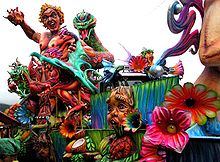Carnaval de Negros y Blancos
| Carnaval de Negros y Blancos | |
|---|---|
 |
|
| Country | Colombia |
| Reference | 00287 |
| Region | Latin America and the Caribbean |
| Inscription history | |
| Inscription | 2009 |
| List | Representative |
 |
|
|
Carnaval de Negros y Blancos |
|
|---|---|
| Official name | Carnaval de Negros y Blancos |
| Also called | Carnavales de Pasto (Pasto's Carnivals) |
| Observed by | Pastusos and southern Colombians |
| Type | Local, historical & cultural |
| Significance | Celebration of Blacks' Holiday and Whites' Day (formerly Epiphany) |
| Celebrations | Carnavalito (Children's Carnival), Arrival of the Castañeda Family, Blacks' Day, Whites' Day & Great parade |
| Begins | 2 January |
| Ends | 7 January |
| Date | Epiphany |
| Frequency | annual |
| Related to | Carnival of Viareggio |
Blacks and Whites' Carnival (Spanish: Carnaval de Negros y Blancos), is the largest carnival celebration in south Colombia, its geographical indication belongs to the city of Pasto. It is celebrated from 2 to 7 January of each year and attracts a considerable number of Colombian and foreign tourists.
On 30 September 2009, this Carnival was proclaimed by UNESCO, as one of the Masterpieces of the Oral and Intangible Heritage of Humanity.
Strictly speaking, the modern carnival, arise at the dawn of an Epiphany day on 6 January 1912, based on the need to express imagination, play, friendship and sharing the joy that around that time of the year revives. In a fine and exclusive brothel in the city, the House of the Misses Robby located in the Calle Real (Royal Street, current 25th Carrera), was the place where the audacity of Don Angel Maria Lopez Zarama, renowned tailor of the city, leads him to take the French face powder of one of the most requested ladies and proceeds to gently spread the powder and some woman's perfume among all those present with the slogan ¡Vivan los Blanquitos! (Hurray the Whiteys!). Soon, the companions of the master cutter and victims of the powder, join the game. Then, everyone would go out to repeat the joke with the unsuspecting parishioners exiting the Kings' Mass from the nearby church of San Juan Bautista, repeating: ¡Que vivan los Negros y que vivan los Blancos! (Hurray the Blacks and Hurray the Whites!) that expression under the custody of Galeras was inserted with force and forever into the essence of Pasto.
However, other cultures and expressions have contributed to the formation of the intricate identity of Pasto's Carnival festivities. This fact characterizes and differentiates it between similar expressions.
Its is also rooted in the rituals performed by the Quillacingas, an agrarian culture, which, at harvest time danced honoring the moon and prayed to the sun, asking protection for their crops.
These ancestral celebrations, with the merger and influence of Spanish culture, give rise to syncretism Hispanic-religious, generating early expressions of what will be the Carnaval of Pasto. In the early 19th century, the colonial authorities banned the holidays to prevent Indian uprisings, by 1834 Indian festivals reappear with churumbeles, mestizos with masquerades and hullabaloo of neighbors mostly, of course all these parties properly framed in the religious calendar, mainly with the festivities of the Virgin of Mercy (24 September) and Immaculate Conception (8 December).
...
Wikipedia
